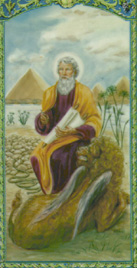
Feastday: April 25
Patron: of notaries, Venice, Barristers
Birth: 1st Century
Death: April 25, 68 AD
Much of what we know about St. Mark, the author of the Second Gospel, comes largely from the New Testament and early Christian traditions. Mark the Evangelist is believed to be the 'John Mark' referred to in the Acts of the Apostles, the history of the early Church found in the Canon of the New Testament.
He was the son of Mary of Jerusalem (Acts 12:12) whose home became a meeting place for the apostles. He is also the cousin of St. Barnabas (Colossians 4:10), a Levite and a Cypriot.
Mark joined St. Paul and St. Barnabas on their first missionary journey to Antioch in 44 A.D. When the group reached Cyprus, Christian tradition holds that Mark left them and returned to Jerusalem, possibly because he was missing his home (Acts 13:13). This incident may have caused Paul to question whether Mark could be a reliable missionary. This created a disagreement between Paul and Barnabas and led Paul to refuse Mark's accompaniment on their second journey to the churches of Cilicia and the rest of Asia Minor.
However, it can be assumed the troubles between Paul and Mark did not last long, because when Paul was first imprisoned, Mark, who was at the time in Rome with plans of visiting Asia Minor, visited him as one of his trusted companions (Col 4:10).
Mark's hopes to visit Asia Minor were most likely carried out, because during Paul's second captivity and just before his martyrdom, Paul wrote to Timothy at Ephesus advising him to "take Mark and bring him with you [to Rome], for he is profitable to me for the ministry" (2 Timothy 4:11). If Mark returned to Rome at this time, he was probably there when Paul was martyred.
According to Christian tradition, Mark also held a close relationship with St. Peter, who referred to Mark has 'his son' in his letter addressed to a number of churches in Asia Minor (1 Peter 5:13). Clement of Alexandria, Irenaeus and Papias all indicate that Mark was an interpreter for Peter.
Although Papias states Mark had not personally heard the Lord speak firsthand and, like Luke, Mark was not one of the twelve apostles, some believe Mark was likely speaking of himself when he wrote the description of Jesus' arrest in Gethsemani. "Now a young man followed him wearing nothing but a linen cloth about his body. They seized him, but he left the cloth behind and ran off naked" (Mark 14:51-52).
St. Mark lived for years in Alexandria, where he died as a martyr while being dragged through the streets.
Mark's Gospel was probably written between 60 and 70 A.D., and was based upon the teachings of St. Peter. It is believed Mark provided both Luke and Matthew with basic sources for their Gospel's.
He was probably the first bishop of Alexandria, Egypt and the founder of the Church of Alexandria, although he is not mentioned in connection to the city by either Clement of Alexandria nor by Origen.
In 828, relics of St. Mark were stolen from Alexandria and taken to Venice, Italy. There they are enshrined in a beautiful cathedral dedicated to the saint.
St. Mark's symbol is a winged lion. This is believed to be derived from his description of St. John the Baptist, as "a voice of one crying out in the desert" (Mark 1:3). The wings come from Ezekiel's vision of four winged creatures as the evangelists.
He is often depicted as writing or holding his Gospel. He is sometimes shown as a bishop on a throne or as a man helping Venetian sailors.
St. Mark is the patron saint of Venice. His feast day is celebrated on April 25.
Author of the Gospel of Mark and Christian saint; traditionally identified with John Mark "Saint Mark" redirects here. For other uses, see Saint Mark (disambiguation).Mark the Evangelist (Latin: Marcus; Greek: Μᾶρκος, romanized: Mârkos; Aramaic: ܡܪܩܘܣ Marqōs) is the traditionally ascribed author of the Gospel of Mark. Mark is said to have founded the Church of Alexandria, one of the most important episcopal sees of early Christianity. His feast day is celebrated on April 25, and his symbol is the winged lion.
Mark's identity
See also: Four Evangelists Mark the Evangelist's symbol is the winged lion, the Lion of Saint Mark. Inscription: PAX TIBI MARCE EVANGELISTA MEVS ("peace be upon you, Mark, my evangelist"). The same lion is also symbol of Venice (on illustration)
Mark the Evangelist's symbol is the winged lion, the Lion of Saint Mark. Inscription: PAX TIBI MARCE EVANGELISTA MEVS ("peace be upon you, Mark, my evangelist"). The same lion is also symbol of Venice (on illustration)
According to William Lane (1974), an "unbroken tradition" identifies Mark the Evangelist with John Mark, and John Mark as the cousin of Barnabas. However, Hippolytus of Rome in On the Seventy Apostles distinguishes Mark the Evangelist (2 Tim 4:11), John Mark (Acts 12:12, 25; 13:5, 13; 15:37), and Mark the cousin of Barnabas (Col 4:10; Phlm 1:24). According to Hippolytus, they all belonged to the "Seventy Disciples" who were sent out by Jesus to disseminate the gospel (Luke 10:1ff.) in Judea.
According to Eusebius of Caesarea (Eccl. Hist. 2.9.1–4), Herod Agrippa I, in his first year of reign over the whole of Judea (AD 41), killed James, son of Zebedee and arrested Peter, planning to kill him after the Passover. Peter was saved miraculously by angels, and escaped out of the realm of Herod (Acts 12:1–19). Peter went to Antioch, then through Asia Minor (visiting the churches in Pontus, Galatia, Cappadocia, Asia, and Bithynia, as mentioned in 1 Peter 1:1), and arrived in Rome in the second year of Emperor Claudius (AD 42; Eusebius, Eccl, Hist. 2.14.6). Somewhere on the way, Peter encountered Mark and took him as travel companion and interpreter. Mark the Evangelist wrote down the sermons of Peter, thus composing the Gospel according to Mark (Eccl. Hist. 15–16), before he left for Alexandria in the third year of Claudius (AD 43).
According to the Acts 15:39, Mark went to Cyprus with Barnabas after the Council of Jerusalem.
According to tradition, in AD 49, about 19 years after the Ascension of Jesus, Mark travelled to Alexandria and founded the Church of Alexandria – today, the Coptic Orthodox Church, the Greek Orthodox Church of Alexandria, and the Coptic Catholic Church trace their origins to this original community. Aspects of the Coptic liturgy can be traced back to Mark himself. He became the first bishop of Alexandria and he is honored as the founder of Christianity in Africa.
According to Eusebius (Eccl. Hist. 2.24.1), Mark was succeeded by Anianus as the bishop of Alexandria in the eighth year of Nero (62/63), probably, but not definitely, due to his coming death. Later Coptic tradition says that he was martyred in 68.
Modern mainstream Bible scholars argue the Gospel of Mark was written by an anonymous author, rather than direct witnesses to the reported events.
Biblical and traditional information
 St Mark in the Nuremberg Chronicle
St Mark in the Nuremberg Chronicle
Evidence for Mark the Evangelist's authorship of the Gospel that bears his name originates with Papias. Scholars of the Trinity Evangelical Divinity School are "almost certain" that Papias is referencing John Mark. Modern mainstream Bible scholars discard Papias's information as unreliable. Eusebius had a "low esteem of Papias' intellect".
Identifying Mark the Evangelist with John Mark also led to identifying him as the man who carried water to the house where the Last Supper took place (Mark 14:13), or as the young man who ran away naked when Jesus was arrested (Mark 14:51–52).
The Coptic Church accords with identifying Mark the Evangelist with John Mark, as well as that he was one of the Seventy Disciples sent out by Christ (Luke 10:1), as Hippolytus confirmed. Coptic tradition also holds that Mark the Evangelist hosted the disciples in his house after Jesus's death, that the resurrected Jesus Christ came to Mark's house (John 20), and that the Holy Spirit descended on the disciples at Pentecost in the same house. Furthermore, Mark is also believed to have been among the servants at the Marriage at Cana who poured out the water that Jesus turned to wine (John 2:1–11).
According to the Coptic tradition, Mark was born in Cyrene, a city in the Pentapolis of North Africa (now Libya). This tradition adds that Mark returned to Pentapolis later in life, after being sent by Paul to Colossae (Colossians 4:10; Philemon 24. Some, however, think these actually refer to Mark the Cousin of Barnabas), and serving with him in Rome (2 Tim 4:11); from Pentapolis he made his way to Alexandria. When Mark returned to Alexandria, the pagans of the city resented his efforts to turn the Alexandrians away from the worship of their traditional gods. In AD 68, they placed a rope around his neck and dragged him through the streets until he was dead.
Veneration
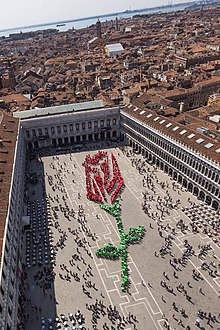 Festa del bocoło (rosebud festival) in St Mark's Square, Venice (Italy)
Festa del bocoło (rosebud festival) in St Mark's Square, Venice (Italy)
The Feast of St Mark is observed on April 25 by the Catholic and Eastern Orthodox Churches. For those Churches still using the Julian Calendar, April 25 according to it aligns with May 8 on the Gregorian Calendar until the year 2099. The Coptic Orthodox Church observes the Feast of St Mark on Parmouti 30 according to the Coptic Calendar which always aligns with April 25 on the Julian Calendar or May 8 on the Gregorian Calendar.
Where John Mark is distinguished from Mark the Evangelist, John Mark is celebrated on September 27 (as in the Roman Martyrology) and Mark the Evangelist on April 25.
Mark is remembered in the Church of England and in much of the Anglican Communion, with a Festival on 25 April.
Relics of Saint Mark
 A mosaic of St Marks body welcomed into Venice, at St Mark's Basilica, Venice.
A mosaic of St Marks body welcomed into Venice, at St Mark's Basilica, Venice.
 Saint Mark, 1411–1413, by Donatello (Orsanmichele, Florence).
Saint Mark, 1411–1413, by Donatello (Orsanmichele, Florence).
In 828, relics believed to be the body of Saint Mark were stolen from Alexandria (at the time controlled by the Abbasid Caliphate) by two Venetian merchants with the help of two Greek monks and taken to Venice. A mosaic in St Mark's Basilica depicts sailors covering the relics with a layer of pork and cabbage leaves. Since Muslims are not permitted to eat pork, this was done to prevent the guards from inspecting the ship's cargo too closely.
Donald Nicol explained this act as "motivated as much by politics as by piety", and "a calculated stab at the pretensions of the Patriarchate of Aquileia." Instead of being used to adorn the church of Grado, which claimed to possess the throne of Saint Mark, it was kept secretly by Doge Giustiniano Participazio in his modest palace. Possession of Saint Mark's remains was, in Nicol's words, "the symbol not of the Patriarchate of Grado, nor of the bishopric of Olivolo, but of the city of Venice." In his will, Doge Giustiniano asked his widow to build a basilica dedicated to Saint Mark, which was erected between the palace and the chapel of Saint Theodore Stratelates, who until then had been patron saint of Venice.
In 1063, during the construction of St Mark's Basilica in Venice, Saint Mark's relics could not be found. However, according to tradition, in 1094, the saint himself revealed the location of his remains by extending an arm from a pillar. The newfound remains were placed in a sarcophagus in the basilica.
Copts believe that the head of Saint Mark remains in a church named after him in Alexandria, and parts of his relics are in Saint Mark's Coptic Orthodox Cathedral, Cairo. The rest of his relics are in Venice. Every year, on the 30th day of the month of Paopi, the Coptic Orthodox Church celebrates the commemoration of the consecration of the church of Saint Mark, and the appearance of the head of the saint in the city of Alexandria. This takes place inside St Mark's Coptic Orthodox Cathedral in Alexandria.
In June 1968, Pope Cyril VI of Alexandria sent an official delegation to Rome to receive a relic of Saint Mark from Pope Paul VI. The delegation consisted of ten metropolitans and bishops, seven of whom were Coptic and three Ethiopian, and three prominent Coptic lay leaders.
The relic was said to be a small piece of bone that had been given to the Roman pope by Giovanni Cardinal Urbani, Patriarch of Venice. Pope Paul, in an address to the delegation, said that the rest of the relics of the saint remained in Venice.
The delegation received the relic on June 22, 1968. The next day, the delegation celebrated a pontifical liturgy in the Church of Saint Athanasius the Apostolic in Rome. The metropolitans, bishops, and priests of the delegation all served in the liturgy. Members of the Roman papal delegation, Copts who lived in Rome, newspaper and news agency reporters, and many foreign dignitaries attended the liturgy.
In art
| This section needs additional citations for verification. (April 2018) |
Mark the Evangelist is most often depicted writing or holding his gospel. In Christian tradition, Mark the Evangelist is symbolized by a lion.
Mark the Evangelist attributes are the lion in the desert; he can be depicted as a bishop on a throne decorated with lions; as a man helping Venetian sailors. He is often depicted holding a book with pax tibi Marce written on it or holding a palm and book. Other depictions of Mark show him as a man with a book or scroll, accompanied by a winged lion. The lion might also be associated with Jesus' Resurrection because lions were believed to sleep with open eyes, thus a comparison with Christ in his tomb, and Christ as king.
Mark the Evangelist can be depicted as a man with a halter around his neck and as rescuing Christian slaves from Saracens.
- Depictions of Mark the Evangelist
-

Venetian merchants with the help of two Greek monks take Mark the Evangelist's body to Venice, by Tintoretto.
-
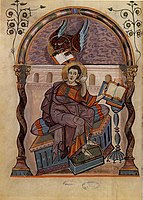
Mark the Evangelist listening to the winged lion, Mark, image 21 of the Codex Aureus of Lorsch or Borsch Gospels.
-
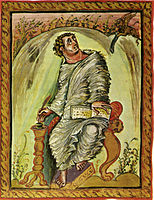
Mark the Evangelist looking at the lion, c.823.
-

The martyrdom of Saint Mark. Très Riches Heures du duc de Berry (Musée Condé, Chantilly), c. 1412 and 1416.
-
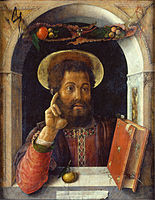
St Mark by Andrea Mantegna, 1448.
-

Mark the Evangelist with the lion, 1524.
-

A painted miniature in an Armenian Gospel manuscript from 1609, held by the Bodleian Library.
-
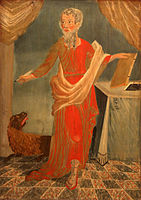
Saint Mark on a 17th-century naive painting by unknown artist in the choir of St Mary church (Sankta Maria kyrka) in Åhus, Sweden.
-

St. Mark writes his Evangelium at the dictation of St. Peter, by Pasquale Ottino, 17th century, Beaux-Arts, Bordeaux.
-

Mark the Evangelist by Il Pordenone (c. 1484 – 1539).
-

Saint Mark the Evangelist Icon from the royal gates of the central iconostasis of the Kazan Cathedral in Saint Petersburg, 1804.
-

An icon of Saint Mark the Evangelist, 1657.
-
Saint Mark's Basilica
Major shrines
- Basilica di San Marco (Venice, Italy)
- Saint Mark's Coptic Orthodox Cathedral (Alexandria, Egypt)
- Saint Mark's Church (Serbian Orthodox) in Belgrade, Serbia
- Saint Mark's Coptic Orthodox Cathedral (Cairo, Egypt)
- St. Mark's Church in-the-Bowery, New York City


















